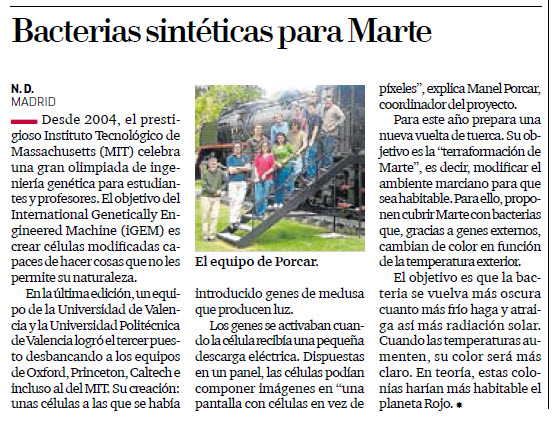Team:Valencia
From 2010.igem.org
Time goes by...
(El tiempo pasa...)
Follow us:

Our main sponsors:

Our institutions:

Visitor location:
The Project
Mad yeasts on Mars?
Under this curious title it is hidden the ambitious Project of Valencia iGEM team. In our project, we intend to present an intermediate scenario in the pathway towards Mars Terraformation (i. e., modifying the atmosphere and temperature of Mars in order to get the appropriate conditions to make it habitable for Terran living organisms). The idea is that, after preliminary changes devoted to make Mars conditions more suitable for life, it can be colonized by microorganisms that will accelerate some changes to make the planet conditions acceptable for plant life which, then, will be able to generate enough oxygen to eventually allow the colonization by animals, including humans.
Obviously, we do not pretend to follow up all the process, but just to focus on the microorganisms’ colonization step, as motors of the atmosphere building and heating, two essential conditions on the Terraformation process.
A consequence of the low Martian atmospheric density, the global temperature on Mars depends mainly on the energy exchange between the planet surface and the solar radiation. Therefore, one way to increase the temperature of the planet would be the change of the albedo altering the color of the surface and making it darker.
Our proposal is that dark yeast cells would retain the arriving solar radiation and heat the surface. But, once the temperature reaches its optimum on the planetary surface, dark cells will no more be necessary and the color production should be switched off. In order to achieve that and taking advantage of Synthetic Biology principles, a switch based on prion proteins (on mad yeast!) will be used.
On the other hand, a big deal with this approach is the resistance of the organism to violent thermal changes of the Martian surface (summer-winter, day-night) which under certain conditions can be in a range of 20ºC and -80ºC. Thus this work will be complemented with the implementation of the expression of an LEA (late embryogenesis abundant) “antifreeze” protein. These proteins in both plants and animals are associated with tolerance to water stress resulting from desiccation and cold shock.
Summarizing, we are going to build a engineered yeast resistant to temperature changes and able to produce a dark pigment which will be the responsible of a global temperature increase on Mars.
News
We are in the local news!!! Check out the article "Synthetic bacteria for Mars"(in spanish in the Publico news paper on Sunday May 23th).
The article tell some of the last year project of the Valencia IGEM 2009 team and then explains this yeas project.
 "
"
